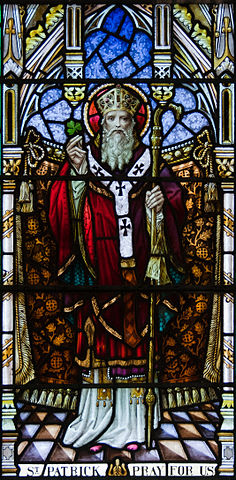
Church of Our Lady, Star of the Sea, and St. Patrick, Goleen, County Cork, Ireland
Photo:Andreas F. Borchert/Wikimedia
St. Patrick is the patron saint of Ireland and known for bringing Christianity to Ireland. He was born in 390 A.D in Britain and raised by a Christian family. However he was not much interested in God and at the time was illiterate. When he was 16, he was kidnapped and taken to Ireland where he was forced to work as a shepherd on a hillside. All alone except for his sheep and captors. he began to cry out to God for rescue him. He had a dream in which God revealed himself and that he would be going home.
Risking his life, he boarded a ship for Britain where he returned to his family. He was welcomed back but realized that he had been transformed by God. He entered a monastery to pursue his calling as a Catholic priest. As a result of his education, he came to understand Holy Scripture and impressed his peers and superiors with his character. He would be made a bishop in due course. Nearly three decades after this slavery in Ireland, he felt a call from God that he had to return to Ireland and spread the word of Jesus to a people who had become lost. This was no easy journey for him since travel was difficult but he faced hostility from those who opposed him trying to convert people away from paganism. Patrick was ready though to face the trials that might take his life (he was attacked and beaten by thugs and Irish royalty disdained him) and persevered in proclaiming the Gospel and training converts.
His courageous leadership and his crisscrossing the countryside paid off as thousands and more would be converted. Churches were being established and he was training those to shepherd the church after he was gone. He would die on March 17, 461 A.D. He has been venerated as a saint and patron saint of Ireland since then by the Roman Catholic, Eastern Orthodox, Anglican and Lutheran churches.

Public Domain/Wikipedia
In Ireland it is a solemnity and thus a holy day of obligation. It is also a cultural day as well to celebrate Ireland. Traditionally many in Ireland will wear shamrocks, wear green, attend Mass, watch parades, have a special breakfast and dinner, and of course celebrate by having a beer in their favorite pub (or outside due to the crowds). It has been a public holiday in Ireland since 1903. Since the feast does fall within Lent and is a solemnity in Ireland, it is permissible to eat foods normally excluded during this time (or any food you have selected to give up). Outside of Ireland though, it is not and local bishops will offer guidance. Usually the bishop will allow those who wish to celebrate to be excused from Friday obligation of fasting but may require you to fast on a different day in the week or the following one.
Fun Fact (or perhaps not)
Many people associate Corned Beef and Cabbage as an Irish dish for St. Patrick’s Day (please do not say St. Paddy’s Day!). However it is not an Irish dish but an Irish-American one. In Ireland of the past, land was precious due to the English seizing lots of it for themselves (and putting many Irish people into indentured servitude in the American Colonies). So people did not have lots of land needed for cows to graze on (you might have a cow for milk but that would be it). Pigs became popular because they require no grazing, can be easily penned, and thus cheaper to keep. So while possibly in the far past they used beef, pork became the preferred meat for many meals and especially for St. Patrick’s Day. When Irish migrated to the United States much later (due to the famine), they discovered corned beef when they saw it being used in Jewish delicatessens. So like dumping turnips for the American pumpkin for the Jack o’ Lantern, corned beef became popular amongst many Irish people since it was easily available unlike in Ireland. And thus was born the now popular corned beef and cabbage amongst Irish Americans.
Important note for 2024
Since his feast day falls on Sunday this year, the church rule is that only one solemnity can be celebrated. So for most dioceses that will honor St. Patrick, this will occur on Monday, March 18 (such as is the case in New York and San Francisco). However since St. Patrick is the patron saint of Ireland, his feast day will be celebrated on Sunday replacing the 5th Sunday of Lent.
The Minstrel Boy
Probably one of the most favored Irish tunes is The Minstrel Boy. Here is a version from Star Trek: The Next Generation episode The Wounded, Following it is a more traditional version. Happy St. Patrick’s Day!
Sources:
“Who Was St. Patrick? – Celebratation, Ireland, Catholic | HISTORY.” HISTORY, 4 Mar. 2024, www.history.com/topics/st-patricks-day/who-was-saint-patrick.
“St. Patrick – Saints and Angels – Catholic Online.” Catholic Online, www.catholic.org/saints/saint.php?saint_id=89.
CATHOLIC ENCYCLOPEDIA: St. Patrick. www.newadvent.org/cathen/11554a.htm.
